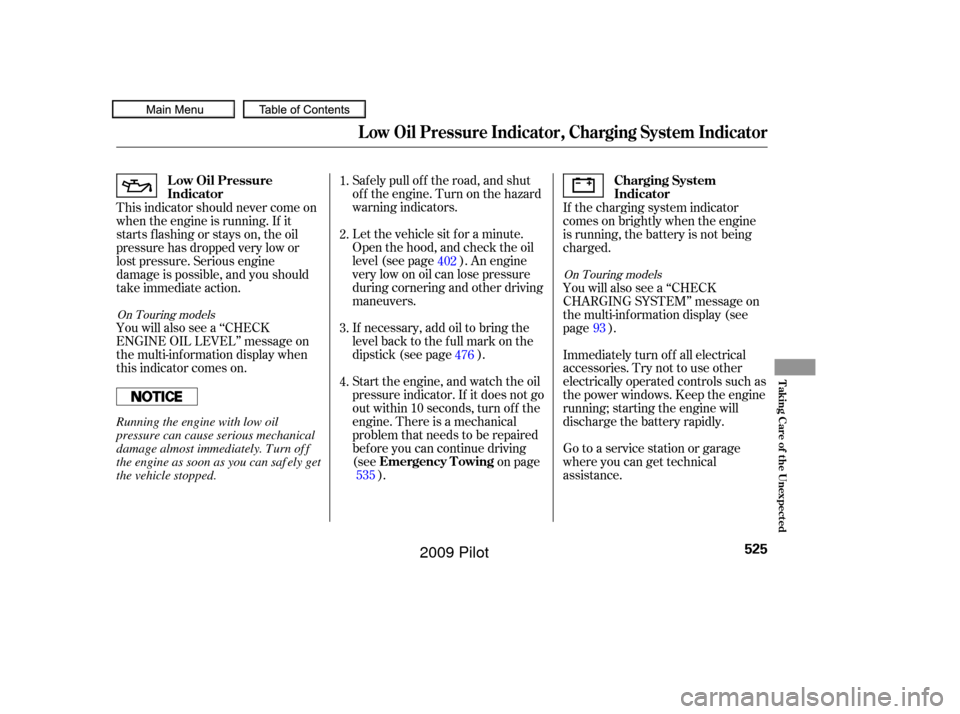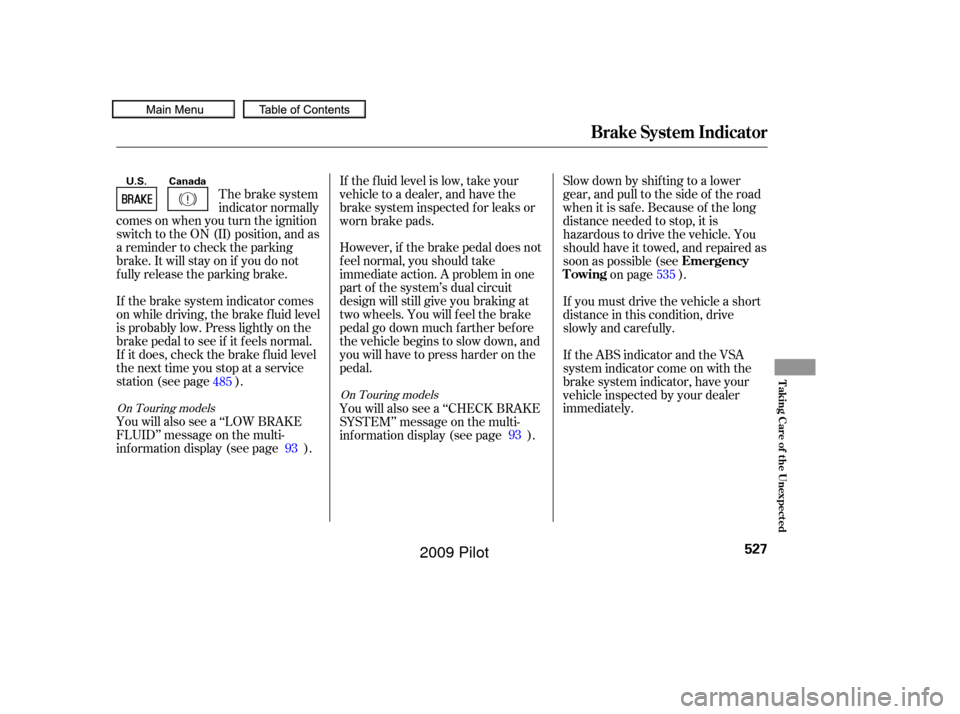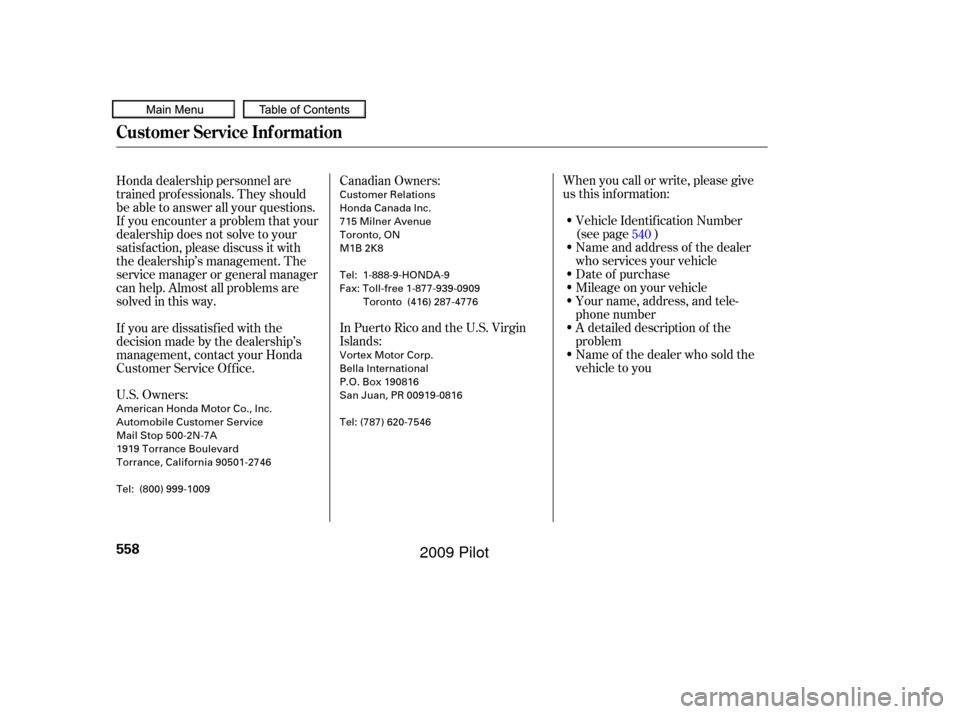Page 522 of 578
Tighten the wheel nuts securely in
the same crisscross pattern. Have
the wheel nut torque checked at
the nearest automotive service
f acility.
Tighten the wheel nuts to:Insert the hoist bracket into the
center hole of the f lat tire.
Remove the center cap from the
flat tire, and place the flat tire
under the hoist, with the valve
stem f acing up.
20. 21.
22.
Changing a Flat Tire
518
94 lbf·ft (127 N·m , 13 kgf·m)
�����—�����—�
���y�
�������������y���
�(�/���������y���������y
2009 Pilot
Page 529 of 578

Saf ely pull of f the road, and shut
of f the engine. Turn on the hazard
warning indicators.
Let the vehicle sit f or a minute.
Open the hood, and check the oil
level (see page ). An engine
very low on oil can lose pressure
during cornering and other driving
maneuvers.
If necessary, add oil to bring the
level back to the full mark on the
dipstick (see page ).
Start the engine, and watch the oil
pressure indicator. If it does not go
out within 10 seconds, turn of f the
engine. There is a mechanical
problem that needs to be repaired
bef ore you can continue driving
(seeon page
).
This indicator should never come on
when the engine is running. If it
starts flashing or stays on, the oil
pressure has dropped very low or
lost pressure. Serious engine
damage is possible, and you should
take immediate action.
If the charging system indicator
comes on brightly when the engine
is running, the battery is not being
charged.
You will also see a ‘‘CHECK
ENGINE OIL LEVEL’’ message on
the multi-information display when
this indicator comes on. Go to a service station or garage
where you can get technical
assistance. Immediately turn of f all electrical
accessories. Try not to use other
electrically operated controls such as
the power windows. Keep the engine
running; starting the engine will
discharge the battery rapidly. You will also see a ‘‘CHECK
CHARGING SYSTEM’’ message on
the multi-information display (see
page ).
1.
2.
3.
4.
402
476
535 93
On Touring models
On Touring models
Emergency T owing
L ow Oil Pressure
Indicator
Charging System
Indicator
L ow Oil Pressure Indicator, Charging System Indicator
T aking Care of t he Unexpect ed
525
Running the engine with low oil
pressure can cause serious mechanical
damage almost immediately. Turn of f
the engine as soon as you can saf ely get
the vehicle stopped.
�����—�����—�
���y�
�������������y���
�(�/���������y���������y
2009 Pilot
Page 531 of 578

However, if the brake pedal does not
f eel normal, you should take
immediate action. A problem in one
part of the system’s dual circuit
design will still give you braking at
two wheels. You will f eel the brake
pedal go down much f arther bef ore
the vehicle begins to slow down, and
you will have to press harder on the
pedal.
The brake system
indicator normally
comes on when you turn the ignition
switch to the ON (II) position, and as
a reminder to check the parking
brake. It will stay on if you do not
f ully release the parking brake.
If the brake system indicator comes
on while driving, the brake f luid level
is probably low. Press lightly on the
brake pedal to see if it f eels normal.
If it does, check the brake f luid level
thenexttimeyoustopataservice
station (see page ). If the f luid level is low, take your
vehicle to a dealer, and have the
brake system inspected f or leaks or
worn brake pads.
Slow down by shif ting to a lower
gear, and pull to the side of the road
when it is saf e. Because of the long
distance needed to stop, it is
hazardous to drive the vehicle. You
should have it towed, and repaired as
soon as possible (see
on page ).
If you must drive the vehicle a short
distance in this condition, drive
slowly and caref ully.
If the ABS indicator and the VSA
system indicator come on with the
brake system indicator, have your
vehicle inspected by your dealer
immediately.
You will also see a ‘‘LOW BRAKE
FLUID’’ message on the multi-
inf ormation display (see page ). You will also see a ‘‘CHECK BRAKE
SYSTEM’’ message on the multi-
inf ormation display (see page ).
485
93 93535
On Touring models
On Touring models
Emergency
Towing
Brake System Indicator
T aking Care of t he Unexpect ed
527
U.S. Canada
�����—�����—�
���y�
�����������
�y���
�(�/���������y���������y
2009 Pilot
Page 539 of 578
The operator will load
your vehicle on the back of a truck.
Any other method of towing will
damage the drive system. When you
contact the towing agency, inf orm
them a f lat-bed is required.
If your vehicle needs to be towed,
call a prof essional towing service or
organization. Never tow your vehicle
with just a rope or chain. It is very
dangerous.
4WD models only
Emergency Towing
The only way you can saf ely tow
your vehicle is with f lat-bed
equipment.
T aking Care of t he Unexpect ed
535
Towing with only two tires on the
ground will damage parts of the 4WD
system. It should be transported on a
f lat-bed truck or trailer.
�����—�����—�
���y�
���������
���y���
�(�/���������y���������y
2009 Pilot
Page 540 of 578
If your vehicle gets stuck in sand,
mud, or snow, call a towing service
to pull it out (see thepreviouspage).
For very short distances, such as
f reeing the vehicle, you can use the
detachable towing hook that mounts
on the anchors in the front and rear
bumpers.
Remove the cover, put cloth on the
edge of the cover and caref ully pry
with a small f lat-tip screwdriver or
a metal fingernail file.Remove the towing hook and
wheel nut wrench placed behind a
cover under the cargo area.
Screw the towing hook into the
hole, and tighten it with the wheel
nut wrench.
The cover is attached to the
bumper with a tether.
1.
2.
3.
If Your Vehicle Gets Stuck
536
Front
COVER WHEEL NUT
WRENCH
TOWING HOOK
�����—�����—�
���y�
�������������y���
�(�/���������y�������
�y
2009 Pilot
Page 548 of 578

The tires on your vehicle meet all
U.S. Federal Saf ety Requirements.
All tires are also graded f or
treadwear, traction, and temperature
perf ormance according to
Department of Transportation
(DOT) standards. The f ollowing
explains these gradings.The treadwear grade is a compara-
tive rating based on the wear rate of
the tire when tested under controlled
conditions on a specif ied government
test course. For example, a tire
graded 150 would wear one and one-
half (1 1/2) times as well on the
government course as a tire graded
100. The relative perf ormance of
tires depends upon the actual condi-
tions of their use, however, and may
depart signif icantly f rom the norm
due to variations in driving habits,
service practices and dif f erences in
road characteristics and climate.The traction grades, f rom highest to
lowest, are AA, A, B, and C. Those
grades represent the tire’s ability to
stop on wet pavement as measured
under controlled conditions on
specif ied government test surf aces
of asphalt and concrete. A tire
marked C may have poor traction
perf ormance.
Warning: The traction grade
assignedtothistireisbasedon
straight-ahead braking traction tests,
and does not include acceleration,
cornering, hydroplaning, or peak
traction characteristics.
All passenger car tires must conf orm
to Federal Saf ety Requirements in
addition to these grades. Quality grades can be f ound where
applicable on the tire sidewall
between tread shoulder and
maximum section width. For
example: Unif orm T ire Quality Grading T readwear
T raction
T readwear 200
Traction AA
Temperature A
DOT Tire Quality Grading (U.S. Vehicles)
544
�����—�����—�
���y�
�������������y���
�(�/���������y���������y
2009 Pilot
Page 561 of 578
....
Customer Service Inf ormation . 558
....................
Warranty Coverages .559
Reporting Saf ety Def ects ..........................
(U.S. Vehicles) .560
.....................
Authorized Manuals .561
Warranty and Customer Relations
Warrant y and Cust omer Relat ions
557
�����—�����—�
���y�
�����������
�y���
�(�/���������y���������y
2009 Pilot
Page 562 of 578

U.S. Owners:When you call or write, please give
us this inf ormation:
Vehicle Identif ication Number
(see page )
Name and address of the dealer
who services your vehicle
Date of purchase
Mileage on your vehicle
Your name, address, and tele-
phone number
A detailed description of the
problem
Name of the dealer who sold the
vehicle to you
Canadian Owners:
In Puerto Rico and the U.S. Virgin
Islands:
Honda dealership personnel are
trained prof essionals. They should
be able to answer all your questions.
If you encounter a problem that your
dealership does not solve to your
satisf action, please discuss it with
the dealership’s management. The
service manager or general manager
can help. Almost all problems are
solved in this way.
If you are dissatisf ied with the
decision made by the dealership’s
management, contact your Honda
Customer Service Office.
540
Customer Service Inf ormation
558
Vortex Motor Corp.
Bella International
P.O. Box 190816
San Juan, PR 00919-0816
Tel: (787) 620-7546
American Honda Motor Co., Inc.
Automobile Customer Service
Mail Stop 500-2N-7A
1919 Torrance Boulevard
Torrance, California 90501-2746
Tel: (800) 999-1009 Honda Canada Inc.
715 Milner Avenue
Toronto, ON
M1B 2K8
Tel: 1-888-9-HONDA-9
Fax: Toll-free 1-877-939-0909
Toronto (416) 287-4776
Customer Relations
�����—�����—�
���y�
�������������y���
�(�/���������y���������y
2009 Pilot